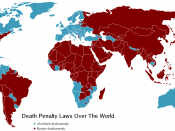Racial Disparity in the Application of the Death Penalty
In today's world, there are many positions for and against the application of the death penalty as a form of punishment. In order to understand the methodology behind the use of the death penalty, the history of the death penalty must be understood. This paper will be discussing the factual history and current facts of whether the death penalty is applied based on race.
In history, as far back as the B.C. (Before Christ) era, the death sentence to severe crimes were carried out by such means as crucifixion, drowning, beating to death, burning alive, and impalement. America was introduced to the death penalty by Great Britain, who at that point was seeking its formal independence. The application of the death penalty first occurred in 1608, when America handed down the death sentence to Captain George Kendall, from Jamestown, Virginia. Kendal was accused and found guilty of being a spy for Spain.
However, since the first use of the death penalty and to the present application thereof, the death penalty has become a heated debate.
In the 1960's the Fifth, Eighth, and Fourteenth amendments were interpreted allowing the death penalty although, capital punishment being considered "cruel and unusual punishment," meant it was unconstitutional by the Eighth amendment. In the Trop v. Dulles (356 U.S. 86) case, the eighth amendment was understood to contain a standard of decency evolving with the progress of a growing society. The Trop v. Dulles case, although did not involve the death penalty, proved as evidence that the death penalty should not be tolerated by the United States due to the "standard of decency" in its growing society. The 1968 case of Witherspoon v. Illinois (391 U.S. 510), the Supreme Court argued that the potential juror's doubts...


